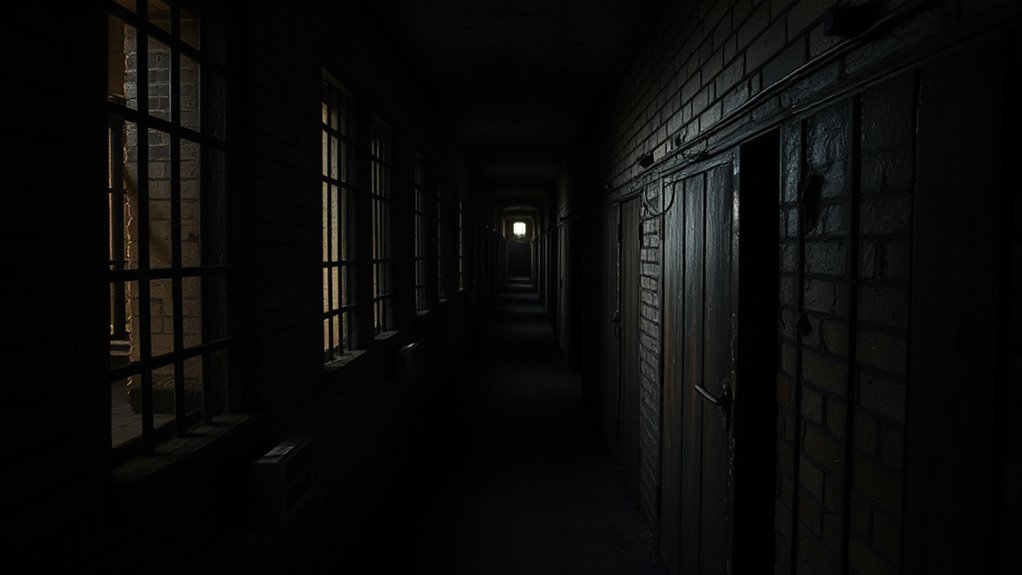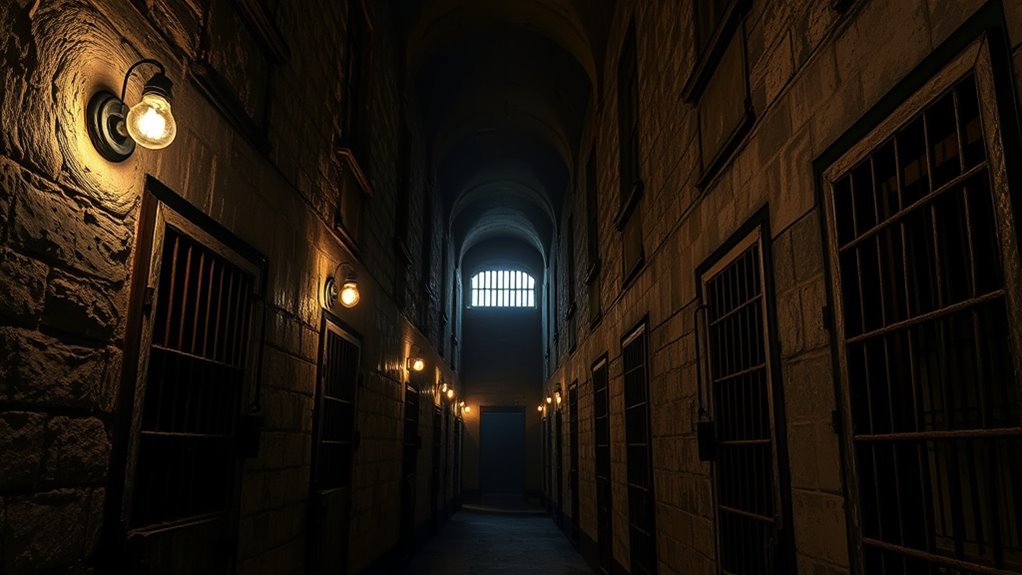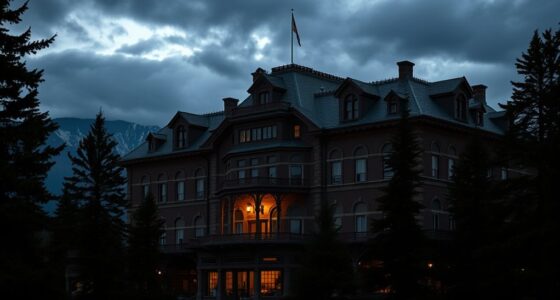Inside Eastern State Penitentiary, you’ll find a prison designed in the 1820s with a radial layout that emphasizes solitude and reflection. Its imposing stone walls and narrow windows reflect its core goal of moral reform through silence and penitence. The architecture aimed to transform inmates emotionally and spiritually, but the long-term isolation often caused distress. If you explore further, you’ll uncover how this haunting prison’s design reveals both revolutionary ideas and the darker side of correctional history.
Key Takeaways
- The penitentiary’s radial design promotes visibility and control, with stark cellblocks radiating from a central hub.
- Built in the 1820s to encourage moral reform through solitude and reflection, embodying the Silent System.
- Its haunting reputation stems from long-term solitary confinement causing psychological distress among inmates.
- The prison’s architecture emphasizes strict discipline, with high stone walls and narrow windows limiting outside contact.
- Today, Eastern State stands as a historic symbol of early correctional ideals and the challenges of humane imprisonment.

Nestled in Philadelphia, Eastern State Penitentiary stands as a haunting reminder of America’s early prison reform movement. As you step inside its historic walls, you’re immediately struck by the unique prison architecture that defines this imposing structure. Designed in the 1820s, the penitentiary’s radial layout was revolutionary for its time, aiming to promote inmate rehabilitation through solitude and reflection. The sprawling cellblocks radiate from a central hub, giving staff clear sightlines and allowing for close supervision. This architectural choice wasn’t just about security; it was about transforming prisoners into better individuals by isolating them from negative influences and encouraging penitence. The design was intended to foster moral reform, emphasizing the belief that solitude could lead to spiritual awakening and personal change.
Walking through the corridors, you realize how the prison’s architecture reflects its core philosophy. Each cell is small, plain, and meant to be a quiet space for inmates to contemplate their actions and seek repentance. The high stone walls and narrow windows limit outside distractions, reinforcing the idea that change must come from within. This focus on inmate rehabilitation shaped many aspects of early prison design, with the hope that confinement would serve as a moral lesson and a chance for renewal. Yet, despite good intentions, the reality of long-term solitary confinement often led to psychological distress, highlighting the complex relationship between prison architecture and inmate well-being. Additionally, the implementation of the silent system aimed to reinforce discipline and reflection, further emphasizing the role of prison architecture in reform.
As you explore further, you notice the innovations that aimed to improve rehabilitation efforts, such as the silent system, which forbade talking among prisoners to maintain order and encourage reflection. The idea was to prevent corruption and promote moral reform through enforced solitude. However, over time, the limitations of this approach became clear, revealing the tension between punishment and rehabilitation. Today, the prison stands as a testament to those early ideas—some successful, others flawed—that sought to improve inmate outcomes through thoughtful design.
Standing amidst the crumbling walls, you can’t help but consider how the very architecture that once aimed to reform inmates now serves as a powerful historical symbol. It reminds us of the ongoing struggle to balance security, humane treatment, and effective rehabilitation within correctional systems. Eastern State’s architecture and history provoke reflection on how far correctional philosophy has come—and how much it still continues to evolve.
Frequently Asked Questions
What Are the Most Haunted Areas Within Eastern State Penitentiary?
You might find the cell block and execution chamber the most haunted areas within Eastern State Penitentiary. Rumors say you can hear whispers and footsteps that aren’t there, especially in these spaces. The cell block’s dark, confined atmosphere amplifies ghostly sightings, while the execution chamber’s chilling history leaves a lingering sense of dread. If you’re exploring, keep your senses alert—these spots are said to be haunted by spirits of the past.
Have Any Paranormal Investigations Confirmed Ghost Sightings Here?
Imagine walking through shadows where whispers of the past linger. Paranormal evidence from ghost investigations at Eastern State Penitentiary has captured eerie phenomena, like unexplained footsteps and shadowy figures. These chilling encounters seem to breathe life into the ghostly legends, confirming sightings that send shivers down your spine. If you seek ghostly proof, the prison’s haunted corners continue to whisper stories, making it a true playground for paranormal investigators and thrill-seekers alike.
What Stories Are Linked to the Prison’S Most Infamous Inmates?
You’re curious about the stories linked to Eastern State Penitentiary’s most infamous inmates. Prisoner legends say some inmates, like Al Capone, still haunt the tunnels, while tales of inmate escapes fuel the prison’s haunted reputation. These stories reveal a dark history of violence and desperation, making the prison a place where ghost sightings and eerie legends persist. Their stories continue to captivate visitors and add to the prison’s haunted atmosphere.
Are There Any Documented Ghostly Voices or Sounds?
Imagine you’re exploring a haunted house, and suddenly, you hear spectral voices whispering in the dark—sounds straight out of a ghost-hunting app. At Eastern State Penitentiary, visitors report auditory phenomena, including chilling voices and unexplained sounds. Many believe these are ghostly voices linked to the prison’s dark history. While there’s no scientific proof, these auditory phenomena continue to thrill and terrify guests, adding to its haunted reputation.
How Has the Prison’s Haunted Reputation Affected Tourism?
Your curiosity about the prison’s haunted reputation shows how it draws many visitors. Ghost tours and paranormal events attract thrill-seekers enthusiastic to experience its spooky history firsthand. This reputation boosts tourism markedly, as people come hoping to encounter ghostly voices or eerie sounds. The prison’s haunted status creates a unique, immersive experience that keeps visitors coming back, keen to explore its haunted past and possibly catch a glimpse of its paranormal activity.
Conclusion
As you walk through Eastern State Penitentiary’s decaying halls, you can almost hear the echoes of those long gone, like ghosts whispering from Poe’s haunted stories. This prison isn’t just a relic; it’s a haunting reminder of America’s dark past, where justice and suffering intertwine. Remember, even in its silence, the ghosts of its history linger, urging us to reflect on the cost of our pursuit of justice and redemption.









